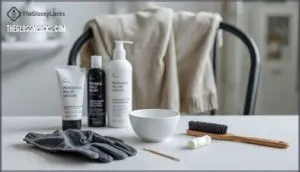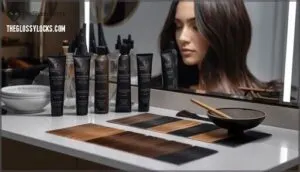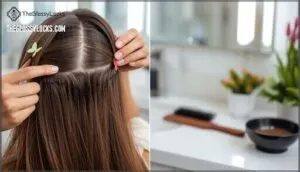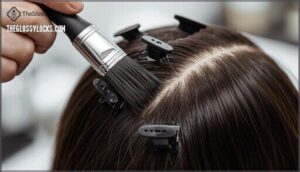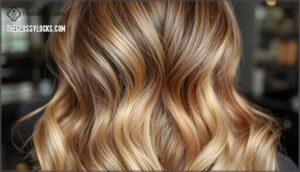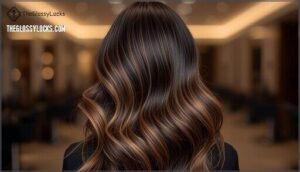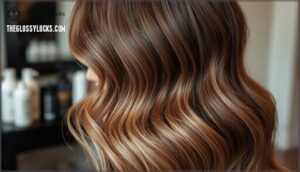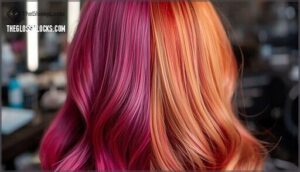This site is supported by our readers. We may earn a commission, at no cost to you, if you purchase through links.
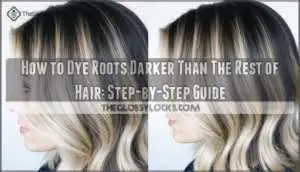
The good news is that darkening your roots strategically doesn’t just cover regrowth; it creates depth and dimension that actually makes your entire color look fresher. Whether you’re going for a rooted blonde, a shadow root effect, or simply blending a noticeable color line, knowing how to dye roots darker than the rest of your hair is the difference between an at-home touch-up that looks obvious and one that looks intentional.
The technique requires precision, but once you understand the order of application and timing, you’ll have control over how your color develops and fades.
Table Of Contents
- Key Takeaways
- Before You Start
- Preparing for The Root Touch Up
- Choosing The Right Shade for Your Roots
- Step-by-Step Guide to Dyeing Roots Darker
- Blending Dark Roots With Blonde Hair
- Reasons for Lighter Roots
- Maintaining Darker Roots
- Troubleshooting Tips
- Frequently Asked Questions (FAQs)
- How to dye a dark hair color?
- Can I dye my roots a darker color?
- How to dye a hairline?
- Why do people want to darken their roots?
- Should I do a root touch up if my hair is darker?
- How do I dye my hair?
- How long do I need to wait to wash my hair after dyeing it?
- Can I use a permanent dye for shadow root hair?
- Does root shadowing work with grey hair?
- How often do I need to touch up my roots?
- Conclusion
Key Takeaways
- Darken roots one to two shades darker than your lengths using permanent dye and precise sectioning, which reduces bleaching frequency by 40% and extends time between salon visits to 8-12 weeks.
- Preparation is critical: conduct a patch test 24-48 hours before, shampoo 24 hours prior to let scalp oil build up, and apply petroleum jelly along your hairline to prevent staining and irritation.
- Process dye for 30-45 minutes at room temperature, rinse with cool water below 40°C for 3-5 minutes to prevent pigment loss, then use sulfate-free products which slow color fade by up to 42%.
- Maintain darker roots by waiting 48-72 hours before shampooing, using cold-water rinses, applying heat protectants, and deep conditioning weekly to extend color vibrancy and hair health between 4-6 week touch-ups.
Before You Start
Before jumping into root shadowing, you need to assess your hair and scalp first. Check your scalp for any cuts, irritation, or conditions like psoriasis that could react badly to dye chemicals. Next, evaluate your hair porosity, which determines how well color absorbs and stays put. High porosity hair grabs color fast but fades quickly, while low porosity hair resists dye penetration and may need clarifying treatments beforehand.
Always conduct a patch test 24 to 48 hours before dyeing to catch potential allergic reactions to ingredients like PPD, which affects up to 7% of people with contact dermatitis. Shampoo your hair about 24 hours before application, skip conditioner, and apply petroleum jelly around your hairline to prevent staining.
Gather your tools: gloves, a bowl, a brush, and your chosen hair color. Preparing your hair with a clarifying shampoo is recommended for some hair types to remove buildup. Proper preparation steps protect your scalp, guarantee even color absorption, and help you achieve salon-quality results at home.
Preparing for The Root Touch Up
Now that you’ve assessed your hair and scalp, it’s time to prepare your workspace and hair properly. This stage makes the difference between uneven color and professional results.
Start by doing a patch test 48 hours before application, since allergic reactions to ingredients like PPD affect roughly 7% of people. Shampoo your hair 24 hours before dyeing to let scalp oil build up—this natural protection reduces irritation by about 30%. Use a clarifying shampoo within a few days of coloring to remove product buildup and boost pigment adherence by up to 25%. If your hair’s been through heat styling, skip it for 48 hours before dyeing for better, more even absorption. Consider researching local salons for top-notch hair coloring if you’re hesitant to DIY.
Here’s what you need ready:
- Patch test results confirming no allergic reactions
- Scalp oil present, with no shampooing the day of application
- Hair treated with clarifying shampoo to remove buildup
- Pre-conditioning mask applied to boost moisture retention by 20%
- Heat styling avoided for 48 hours prior
Gather your supplies: gloves, petroleum jelly (apply along your hairline to prevent staining), a non-metal bowl, an applicator brush, and your chosen hair dye. Set up in a well-lit space with good ventilation. Drape old towels or a protective cape around your shoulders—dye transfer happens in 85% of cases without protection. You’re now ready to move forward with confidence.
Choosing The Right Shade for Your Roots
Now that you’ve prepped your hair and workspace, the next step is picking the right shade. This is where your results really come together, so getting it right matters.
The key is matching your undertone and considering how much contrast you want. Here are your options:
- Gentle blending: Choose a shade one level darker than your mid-lengths, staying within the same color palette as your natural hair for even blending.
- Moderate contrast: Go two shades darker for noticeable depth without high maintenance or the need for frequent bleaching sessions.
- Bold statement: Select a tone more than two shades darker for dramatic impact, though this requires commitment to upkeep.
Think about your hair’s genetic factors too. If you naturally have higher eumelanin (common in brunettes), darker formulations will hold better. Lighter bases reflect more light, so the contrast between roots and lengths appears stronger visually.
When selecting your developer, remember that a 20-volume developer lifts natural pigment efficiently without over-processing. Match your dye’s tone to your hair’s warmth—cool ash tones offset oxidation warmth, keeping everything consistent as your hair regrows.
Step-by-Step Guide to Dyeing Roots Darker
Now that you’ve chosen your shade, it’s time to actually apply it. The process is straightforward once you know what you’re doing, and breaking it down into clear steps will help you avoid mistakes.
Follow along with each stage, and you’ll have darker roots that blend seamlessly with the rest of your hair.
Step 1: Create Sections
Think of sectioning like creating a roadmap for your dye application—it’s the difference between hitting every root and missing important spots. Divide your hair into four quadrants using a center part from your forehead to your nape, then an ear-to-ear section across the crown. This "hot cross bun" technique ensures even dye distribution and prevents overlapping, which can create unintended darker patches.
Clip each section securely with heat-resistant butterfly clips, then subdivide into half-inch strands working from bottom to top. The payoff? Professional-style coverage that’s 30–40% more consistent than unsectioned application, plus a 20% faster process.
| Tool | Purpose |
|---|---|
| Rat-tail comb | Clean, symmetrical parting |
| Butterfly clips | Secure sections without slipping |
| Tint brush | Precise dye placement |
Step 2: Apply Dye to Roots
Now that your hair is sectioned, mix your dye in a 1:1 ratio with activator for a thick, creamy consistency that won’t drip.
Starting at your hairline and part—the most visible areas—apply the dye directly to your regrowth using a precision brush, working through each half-inch subsection. Use a tail comb to weave through sections for even saturation while avoiding overlap with previously colored hair.
Massage gently once finished. This application precision prevents patchy coverage and keeps your roots looking intentional, not accidental.
Step 3: Process and Set The Color
Once the dye contacts your roots, time becomes critical. Processing usually takes 30 to 45 minutes for permanent color to develop fully, though bleached or porous hair absorbs dye roughly 1.5 times faster, so monitor closely. The chemical reactions locking color molecules into your hair cortex determine both shade depth and how long your darker roots stay vibrant. Don’t cut corners on timing—that’s where most people’s root touch-ups fail.
Here’s what matters during this phase:
- Keep roots at standard room temperature (20–22°C) for consistent, predictable results
- Avoid heat lamps unless intentional, as they accelerate processing by 7–10 minutes and risk cuticle damage
- Check porosity—previously treated hair needs shorter timing since it holds color differently
- Follow your dye’s exact instructions; skipping steps cuts longevity by 21% and causes patchiness in 22% of cases
Step 4: Rinse and Dry
Once processing finishes, rinsing becomes your critical next step. Use cool or lukewarm water—never hot—since temperatures above 40°C open your hair’s cuticle layer by 18–20%, letting color molecules escape. Rinse for 3–5 minutes until water runs clear, removing all dye residue without overdoing it; excessive rinsing beyond 10 minutes causes up to 12% pigment loss in semi-permanent dyes.
| Rinsing Temperature | Water Quality | Drying Methods | Conditioner Usage | Color Longevity |
|---|---|---|---|---|
| Cool/lukewarm (below 40°C) | Filtered or distilled | Gentle heat at 47°C, 15cm distance | Color-safe conditioner immediately | Retains 90% intensity |
| Hot water | Chlorinated tap | High heat above 95°C | Standard conditioner | Fades faster, ΔE increases 2.1 units |
| Varies | Hard water (100+ ppm calcium) | Air-drying | Leave-in UV filters | Dulls by 30% after 10 washes |
| Below 40°C best | Filtered water | Ionic dryer at moderate settings | Weekly deep-conditioning masks | Extends 50% under sunlight |
| Cold rinse final step | Distilled preferred | Natural air-dry | Keratin-enriched formulas | Up to 96–100% retention at ≤2 weekly washes |
Follow with a color-safe, sulfate-free shampoo and nourishing conditioner to lock in moisture and restore protein integrity. Dry gently using moderate heat rather than high temperatures, which cause visible darkening and structural damage within minutes. This foundation determines how long your darker roots stay vibrant.
Blending Dark Roots With Blonde Hair
When you’re blending dark roots with blonde hair, you’re basically creating a gradient that tricks the eye into seeing a polished, lived-in look. Root smudging and reverse balayage are your best techniques here—they soften the line between dark and light by feathering color downward into your lengths.
Root smudging and reverse balayage create gradients that blend dark roots with blonde by feathering color downward, extending salon visits while reducing frequent bleaching damage
For blonde toning, aim to go one or two shades darker at the roots, then fade that color gradually outward. This approach reduces bleaching frequency by roughly 40%, which means healthier hair overall.
The key is irregular application—make some streaks shorter, others longer—so the blend feels natural rather than painted on. You’ll extend the time between salon visits to 8–12 weeks, and your color will hold better because you’re not constantly processing your whole head.
Reasons for Lighter Roots
Your roots naturally lighten for reasons you can actually control—or at least understand. Genetic predisposition plays the biggest role; over 90% of root color variation comes from your family history, meaning if your parents had lighter roots, you likely will too.
Age matters too—melanocyte activity declines about 20% per decade after 30, so lighter roots become more noticeable as you get older.
Beyond genetics, hormonal shifts during menopause, thyroid issues, and even vitamin B12 deficiency can accelerate depigmentation at your roots. Environmental influences like UV exposure, smoking, and pollution contribute further, while chronic stress can trigger reversible lightening in up to 17% of cases.
Understanding these factors helps you decide whether dyeing roots darker suits your needs.
Maintaining Darker Roots
Your darker roots won’t stay flawless without intentional care. Think of them like a fresh paint job—without maintenance, they fade. Here’s what keeps shadow roots looking sharp:
- Use sulfate-free shampoos to slow pigment loss by up to 42% compared to conventional detergents
- Apply heat protectants before styling to reduce color oxidation by 30–50%
- Rinse with cold water to lock in dye molecules and improve retention by about 12% per wash cycle
- Deep condition weekly to restore structural protein lost during dyeing, maintaining hair health alongside color longevity
Between salon visits, root touch-up powders and sprays extend your appointment by 3–5 weeks. Cold-water rinses preserve pigment longevity while protecting your scalp.
These lifestyle influences—UV exposure, chlorinated water, high heat—strip surface pigments quickly, so product selection matters. Professional color-safe formulas maintain fade resistance far better than generic alternatives. Your darker roots deserve the same attention you gave them during application.
Troubleshooting Tips
Even with the best prep work, things don’t always go perfectly when you’re dyeing your own roots. Uneven color, patchy coverage, and hot roots happen more often than you’d think, but they’re fixable.
The most common issue is heat from your scalp speeding up the dye process, sometimes by double, which can make roots darker or lighter than intended. That’s why applying dye to uncolored regrowth only—avoiding any overlap with previously colored hair—matters so much. Overlapping old and new dye zones compounds the problem, making damage worse.
Here’s what helps:
- Section your head into four quadrants to decrease patchy coverage by nearly 30% and catch missed spots
- Use a lower developer (10 volume) to prevent overprocessing and preserve color saturation at the base
- Apply Vaseline along your hairline to stop dye bleeding and scalp irritation before it starts
- Wait the full 40 minutes but not longer—even 2 minutes extra can shift your shade by 10%
If dye roots darker than expected, a cool-toned toner neutralizes excess warmth. Touch up every 4 weeks, and remember: sulfate-free products slow pigment fade by 42%, so they’re worth the investment.
Frequently Asked Questions (FAQs)
How to dye a dark hair color?
Dyeing hair dark requires selecting the right dark dye type—permanent formulas last six to twelve weeks—then applying it evenly to avoid patchy results.
Always perform a patch test first to prevent allergic reactions from ingredients like PPD.
Process for the recommended time, then rinse with cold water and use color-safe products to extend vibrancy.
Can I dye my roots a darker color?
Yes, you can absolutely dye your roots darker. It’s entirely feasible and one of the most popular hair trends right now.
Success depends on choosing the right shade—usually one to two shades darker than your lengths—and applying dye precisely to roots only.
Proper technique, processing time of 20–45 minutes, and maintenance guarantee lasting results.
How to dye a hairline?
Your hairline demands respect—it’s more delicate than the rest of your scalp. Use lower developer volume, usually 10 or 20, to prevent over-processing finer hair there.
Apply dye last to your hairline, not first, timing it carefully for 5-10 minutes maximum to avoid damage and uneven color absorption at this sensitive zone.
Why do people want to darken their roots?
Most people darken their roots to conceal new growth and blend color transitions seamlessly. It creates a natural, dimensional look that extends time between salon visits.
Darker roots also reduce the need for frequent full-head treatments, minimizing chemical damage while maintaining that polished, low-maintenance appearance you’re after.
Should I do a root touch up if my hair is darker?
If your hair’s already dark, a root touch-up keeps everything uniform and prevents that telltale regrowth line.
Darker roots upkeep prevents color banding, maintains your shade consistency, and extends salon visits—especially if you’ve lightened your lengths.
Root touch benefits include a polished look and reduced damage from full-head coloring.
How do I dye my hair?
Dyeing your roots darker involves selecting a shade one to two shades deeper than your lengths, then applying dye irregularly to roots for a natural blend. Section hair, apply color carefully to avoid damage, and process for 40 minutes.
Use sulfate-free shampoo afterward to prevent allergic reactions and maintain even coverage throughout.
How long do I need to wait to wash my hair after dyeing it?
It seems backwards, but waiting is actually what makes your color stick around. Give it 48 to 72 hours before shampooing—this lets dye chemical reactions fully complete and cuticle sealing lock everything in. Hot water speeds up color fading, so use cool water when you finally rinse.
Your hair’s porosity affects timing too; more porous hair needs the full window.
Afterward, sulfate-free shampoos and minimal washing keep that investment vibrant longer.
Can I use a permanent dye for shadow root hair?
Permanent dye works well for shadow roots. Choose a shade one to two tones darker than your lengths, then apply it directly to uncolored roots using precision techniques.
Ammonia-based formulas penetrate deeply for long-lasting color and natural blending, though proper application prevents demarcation lines and color buildup that can complicate maintenance and cause damage.
Does root shadowing work with grey hair?
Yes, root shadowing works with grey hair, but grey presents unique challenges. Grey lacks melanin, making it resistant to dye uptake and prone to uneven absorption.
You’ll need demi-permanent or permanent color with adequate developer strength. Apply strategically to resistant areas first, use heat during processing, and follow with toner to neutralize brassiness.
Expect touch-ups every four to six weeks for natural blending.
How often do I need to touch up my roots?
Most hair professionals recommend touching up your roots every 4 to 6 weeks, aligned with your hair’s natural growth rate of approximately half an inch monthly.
Higher contrast between darker roots and lighter lengths increases visibility, prompting more frequent maintenance.
You can extend intervals between touch-ups by using root concealers, semi-permanent dyes, or blending techniques that reduce color contrast, minimizing damage while keeping your look fresh longer.
Conclusion
Mastering how to dye roots darker than the rest of your hair means mastering control over your color. Mastering control means mastering the confidence to refresh your look intentionally.
You’re not just covering regrowth anymore—you’re creating dimension that makes your entire shade look richer and more intentional. This technique works because timing and placement matter, and now you understand both.
Your next root touch-up won’t feel like damage control; it’ll feel like the deliberate choice it actually is.
- https://makeuptutorials.com/how-to-dye-roots-darker-rest-hair/
- https://www.wikihow.com/Darken-Roots
- https://www.instructables.com/How-to-Do-a-Color-Melt/
- https://www.madison-reed.com/blog/fall-hair-color-trend-alert-root-shadowing
- https://joshwoodcolour.com/blogs/community/how-to-colour-your-grey-roots-and-refresh-your-ends

